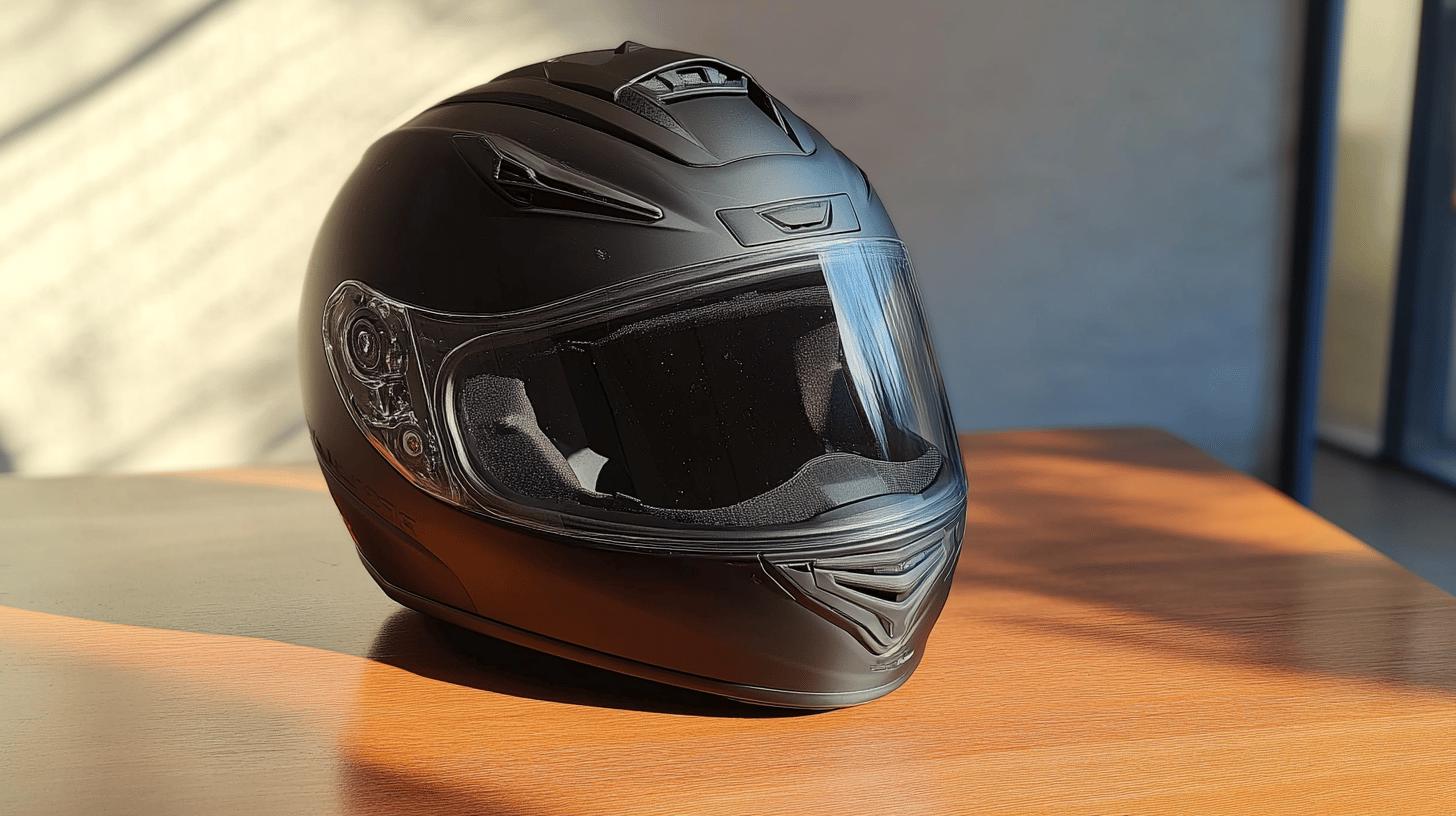Ever wondered why your motorcycle helmet visor fogs up at the most inconvenient times? It’s a safety hazard that every rider has faced.
When the inside's warmth meets the cooler outside air, especially with full-face helmets, fog sneaks in, obscuring vision. Understanding this nuisance isn’t just about comfort; it’s about safe riding.
Dive into the main causes of helmet fogging and discover actionable solutions that can restore the clarity of your ride, keeping every journey safe and fog-free.
Understanding Why Motorcycle Helmets Fog Up

Motorcycle helmet fogging primarily occurs due to condensation. What is condensation? Condensation is the process where water vapor in the air transitions into liquid droplets when it comes into contact with a cooler surface.
In the context of a helmet visor, the warm, moist air from a rider's breath meets the cooler surface of the visor, leading to the formation of these droplets. This phenomenon is especially prevalent in colder weather when the temperature difference between the inside and outside of the helmet is more pronounced, causing the visor to fog up and obscure vision.
Environmental factors such as temperature and humidity play a significant role in helmet fogging. How do temperature and humidity affect fogging? The answer lies in how these elements influence moisture in the air.
High humidity increases the amount of moisture available to condense on the visor, while lower temperatures exacerbate the potential for condensation by making the visor surface cooler. Riders often encounter this issue during early morning rides or in rainy conditions when both humidity and temperature differentials are heightened, making it a frequent challenge to maintain clear visibility.
Helmet design can also contribute to the fogging problem. Why do full-face helmets fog more frequently? Full-face helmets cover the mouth and nose, trapping more warm air inside the helmet. This trapped air, combined with the lack of ventilation, creates an ideal environment for condensation on the visor.
The design of the helmet, including the positioning of vents and the type of visor used, can either mitigate or exacerbate fogging. Full-face helmets, while offering increased protection, often require additional anti-fog measures to keep vision unobstructed, especially in challenging weather conditions.
Practical Tips for Preventing Helmet Fogging

Ventilation is key in preventing helmet fogging. Why is ventilation so critical? It regulates airflow within the helmet, reducing the build-up of warm, moist air that leads to condensation on the visor. Effective ventilation helps maintain a balance between the inside and outside temperatures, minimizing the risk of fogging. By ensuring that the helmet's venting system is fully functional, riders can significantly enhance visibility and safety.
-
Open all vents, especially those around the chin, to direct exhaled air away from the visor.
-
Slightly lift the visor to allow a small gap for air circulation without compromising safety.
-
Adjust the helmet's air channels to optimize airflow based on riding conditions.
-
Regularly clean and check vents for blockages to maintain efficient airflow.
-
Use a breath deflector to redirect warm air away from the visor surface.
Creating a gap using fabric or tape can be an effective method to increase airflow. How does this work? By placing a small piece of tape or fabric between the visor and helmet seal, a slight opening is created. This allows cold air to enter and warm air to escape, helping to clear fog quickly. This simple modification is particularly useful in colder weather when fogging is more prevalent.
The fit of a helmet plays a crucial role in ventilation. How does fit affect fogging? A properly fitted helmet ensures that vents align correctly with the rider's facial features, optimizing airflow. If a helmet is too tight, it can restrict airflow and contribute to fogging. Conversely, a helmet that's too loose may not effectively channel air through its designed pathways, reducing its ability to prevent fogging.
Riders have shared numerous real-world solutions to combat helmet fogging. Many report success by experimenting with different ventilation settings and using breath deflectors. For instance, some riders have found that slightly opening the visor during stops reduces fog build-up. Others have adjusted their riding position to maximize airflow through the helmet's vents. These shared experiences underscore the importance of finding personalized solutions that align with individual riding habits and preferences.
Anti-Fog Products and Their Effectiveness

Motorcycle riders have several anti-fog solutions available to maintain clear visors. These products include anti-fog inserts, pin-lock systems, sprays, and coatings. Each option offers varying levels of effectiveness and durability, catering to different riding needs and preferences.
Anti-fog inserts are clear plastic sheets that attach to the inside of helmet visors. How do these inserts work? They absorb moisture through a hydrophilic layer, preventing condensation from forming. This process is particularly effective in keeping the visor clear during rainy or humid conditions. The simplicity of their application and the low cost make them a popular choice among riders seeking an easy and efficient fog-prevention method.
Pin-lock systems provide a more advanced solution by creating a double-glazed effect. What does this mean for riders? The pin-lock maintains a constant temperature inside the visor, preventing fog even when faced with sudden temperature changes. Riders often favor pin-lock inserts for their durability and reliability, particularly during long rides in variable weather conditions. They are considered a worthwhile investment for those looking to avoid regular maintenance.
Anti-fog sprays and coatings offer flexible options for fog prevention. Sprays require frequent application but provide immediate results. What are the benefits of anti-fog coatings? Coatings offer a more permanent solution, lasting several months or even years with proper care. While sprays are convenient for temporary fixes, coatings are ideal for riders seeking long-term protection without constant reapplication.
| Product Type | Effectiveness | Longevity |
|---|---|---|
| Anti-Fog Inserts | Moderate | Short-term |
| Pin-lock System | High | Long-term |
| Anti-Fog Spray | Variable | Short-term |
| Anti-Fog Coating | Consistent | Long-term |
Selecting the best anti-fog product depends on individual riding conditions and preferences. Riders in humid or rainy climates might benefit more from pin-lock systems or coatings, due to their durability and low maintenance. Meanwhile, those in variable conditions may prefer the ease of anti-fog sprays or inserts for their convenience and adaptability. By considering the effectiveness and longevity of each product, riders can tailor their choice to ensure a clear and safe riding experience.
The Role of Helmet Design in Fogging Prevention

Helmet design has significantly evolved to address the persistent issue of fogging. How has helmet design changed over time? Modern helmets incorporate advanced materials and features aimed at mitigating fogging, such as enhanced ventilation systems and moisture-wicking liners. The integration of these elements reflects the industry's response to the demand for clearer, safer riding experiences, especially in challenging weather conditions.
Specific design features play a crucial role in reducing fogging. What features help prevent fogging? Vent placement is pivotal, as strategically positioned vents promote airflow, reducing the likelihood of condensation. Additionally, many helmets now include built-in anti-fog solutions like pin-lock systems and anti-fog coatings. These features work by either absorbing moisture or maintaining a consistent temperature on the visor, effectively keeping it clear during various riding scenarios.
Riders should carefully evaluate helmet features to minimize fogging. How can riders choose helmets that prevent fogging? When purchasing a helmet, it's essential to consider the design aspects that impact airflow and moisture control. Checking for adequate venting, compatibility with anti-fog inserts, and the presence of built-in fog-prevention technology can make a significant difference. By doing so, riders can select helmets that align with their specific needs, ensuring a clear and safe ride.
User Experiences and Anecdotal Solutions to Helmet Fogging

Community-shared knowledge is invaluable for riders facing helmet fogging issues. Why is this communal insight so beneficial? Riders often encounter similar challenges and can offer practical, real-world solutions that have been tested on the road.
These shared experiences, documented in forums and blogs, provide a wealth of DIY methods and adjustments that help mitigate fogging. By tapping into this collective wisdom, motorcyclists can discover new techniques tailored to their specific needs and riding conditions.
-
Apply a small amount of shaving cream to the inside of the visor and buff it out to prevent fogging.
-
Use a potato slice to rub the visor's interior, creating a thin film that reduces fogging.
-
Position a tissue or paper towel inside the helmet to absorb moisture and reduce humidity.
- Experiment with dish soap on the visor's surface, allowing it to dry, then buffing it off for a temporary anti-fog layer.
Encouraging experimentation with different methods is crucial for finding effective solutions. How can riders benefit from trying various techniques? By testing multiple approaches, motorcyclists can identify what works best for their specific helmet and environment.
Sharing these findings within the riding community not only enhances individual safety but also contributes to a broader pool of knowledge that can benefit all riders. Engaging with fellow motorcyclists and exchanging tips helps foster a supportive environment where everyone can enjoy a clearer, safer ride.
Final Words
Motorcycle helmet fogging arises from temperature differences and humidity, impacting visibility. Solutions include improving ventilation, utilizing anti-fog products, and selecting well-designed helmets. Practical tips like adjusting vents and using anti-fog sprays enhance riding safety.
Choosing the right gear and methods greatly influences a fog-free riding experience. Riders are urged to explore various strategies and connect with fellow motorcyclists for shared solutions, fostering a sense of community and continually improving the riding experience.
FAQ
Q: Why does my motorcycle helmet fog up?
A: Motorcycle helmets fog up due to temperature differences creating condensation on the visor, commonly when the warm, moist air from exhalation meets the cooler visor surface.
Q: How do I stop my motorcycle helmet from fogging up?
A: To prevent helmet fogging, improve ventilation by opening vents, use anti-fog inserts like Pinlock, or apply anti-fog spray. Adjust the visor to allow moisture to escape.
Q: How can I keep my head cool in my motorcycle helmet?
A: Enhancing airflow through proper vent adjustment and selecting helmets with advanced cooling features can help keep your head cool while riding.
Q: What are effective anti-fog products for motorcycle helmets?
A: Anti-fog inserts, Pinlock systems, and sprays are effective. Inserts maintain constant temperature; sprays need regular application. Coatings offer a long-lasting solution.
Q: How do helmet design features prevent fogging?
A: Modern helmets often include built-in anti-fog features like pin-lock systems and strategic vent placements to reduce fogging and enhance airflow.
Q: Are there any DIY helmets anti-fog methods that work?
A: DIY methods, such as using shaving cream or creating gaps with fabric, have been successful according to rider anecdotes and can be a cost-effective alternative.

Brad Mitchell is a seasoned motorcycle enthusiast with over 16 years of riding experience. He’s spent countless hours on the open road, particularly favoring scenic routes aboard his trusted Harley-Davidson. Brad’s laid-back approach to life and riding gives him a unique perspective on motorcycle gear and safety, which he shares through his in-depth reviews and expert advice on ProtectiveGearz.



